Intermarkets' Privacy Policy
Donate to Ace of Spades HQ!
aceofspadeshq at gee mail.com
Buck:
buck.throckmorton at protonmail.com
CBD:
cbd at cutjibnewsletter.com
joe mannix:
mannix2024 at proton.me
MisHum:
petmorons at gee mail.com
J.J. Sefton:
sefton at cutjibnewsletter.com
Even CNN Admits That the Lunatic Lesbian Leftist Tried to Run Down the ICE Agent
Iran's Supreme Ayatollah: Protesters Are Just Working On Behalf of Donald Trump
US Marines Seize Another False-Flag Ship of the "Dark Fleet"
Helen Andrews: Somalis Have Been Scamming the Government Since They Got Here
Thanks to MAHA, Several States Just Implemented Bans on Using SNAP Benefits for Junk Food; also, A Friend of the Blog Is Running for Statewide Office in Nevada
Mid-Morning Art Thread
The Morning Report — 1/9/26
Daily Tech News 9 January 2026
Thursday Overnight Open Thread - January 8, 2026 [Doof]
Jim Sunk New Dawn 2025
Jewells45 2025
Bandersnatch 2024
GnuBreed 2024
Captain Hate 2023
moon_over_vermont 2023
westminsterdogshow 2023
Ann Wilson(Empire1) 2022
Dave In Texas 2022
Jesse in D.C. 2022
OregonMuse 2022
redc1c4 2021
Tami 2021
Chavez the Hugo 2020
Ibguy 2020
Rickl 2019
Joffen 2014
maildrop62 at proton dot me
TBD
Spaced-Out Challenge: Messier Marathon Mega-Thread (Part 1)
[We Politely Request That All Off-Topic or Political Comments Be Directed to the Open Thread down page, Which Will Serve Officially as the Current "Active Conversation" Thread for All Discussions Not Related To This Topic. Enjoy!]
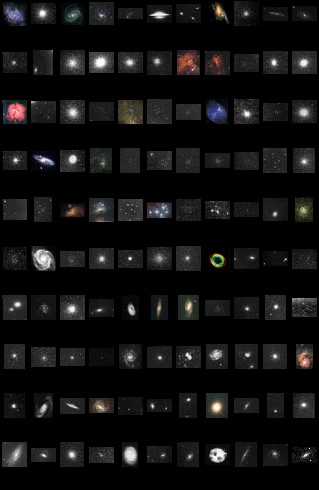
Welcome again to the Spaced-Out Challenge! Whether you have a question about equipment, a new astronomical discovery you want to expand on, or just want to kick back and enjoy the cosmos above, come one come all on our weekly astronomical journey.
March is my favorite month of the year. Beyond having a birthday and St. Patrick's Day back-to-back, it marks a time of great transition, as winter yields to spring. It also presents the only opportunity to see the whole year's night sky in a single evening, and 2014 is extra special: the weekend of March 1st-2nd and the 29th-30th feature new moons! My friends to the North should stick with the month's end, but those of you blessed to live at my latitude (35N) can pick either for the greatest scavenger hunt in the sky: the Messier Marathon!
This week's edition is very, very, very, very, very big, as such the margins have been slightly tweaked for moar oohs and embiggenments. From general maps to custom planning guides, fabulous astrosketches and photography to our comprehensive fifty-state dark sky directory, everything you need to tackle the marathon is right here. So set your eyes to the sky, and let's go!
A toughie for beginners and experts alike, the Messier Marathon is rather straightforward: catch all 110 Messier objects in a single evening. Comet hunter David Levy was one of the first to accomplish this back in 1983, and astronomy clubs across the world began hosting star parties for the event around the same time. Some of the most beautiful deep sky objects are on the list, so even if you fall grossly short of catching them all (for the record, I've only managed to catch 90 of 'em), your efforts will be rewarded greatly.
Note: the time approximations are for the month of March only. Almost all of them are available for all-night observation at some point during the year. While aiming for all 110 is very ambitious, we are going to focus on a substantial portion of the list which offer amateurs a wide range of targets of varying difficulty. You DO NOT NEED a telescope to see the objects listed here: just dark skies and 15x70 binoculars will be just dandy- but having a scope takes the targets from awe to awesome.
Refer to this large pop-out chart to orient yourself: View image
The hours immediately following sunset are critical for catching some of the bright fall galaxies, and attempts should start on them within 45 minutes of sunset.
The Triangulum Galaxy (M33)
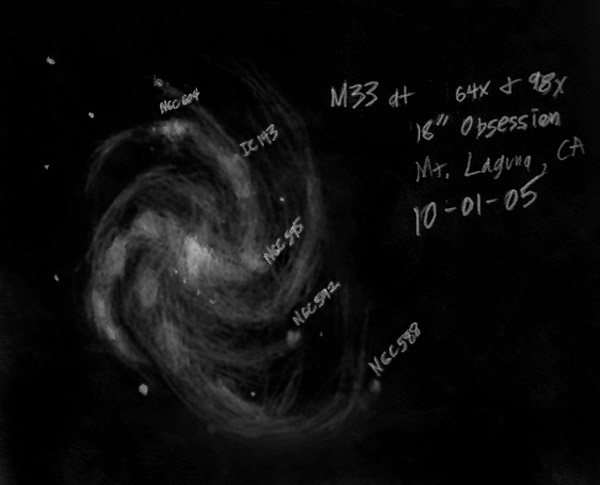
Drawing a line between Hamal and Mirach, and roll about 2/3rds of the way to Mirach, and you'll land on a beautiful spiral galaxy, sometimes called the Pinwheel. It is a great indicator of sky darkness: when high overhead in the fall, M33 is clearly visible from truly dark sites. An intriguing smudge in binoculars, it can be a real jaw dropper in even modest scopes from pristine sites. It is low in the sky in March, however, so hunt for it early.
Cetus A (M77)
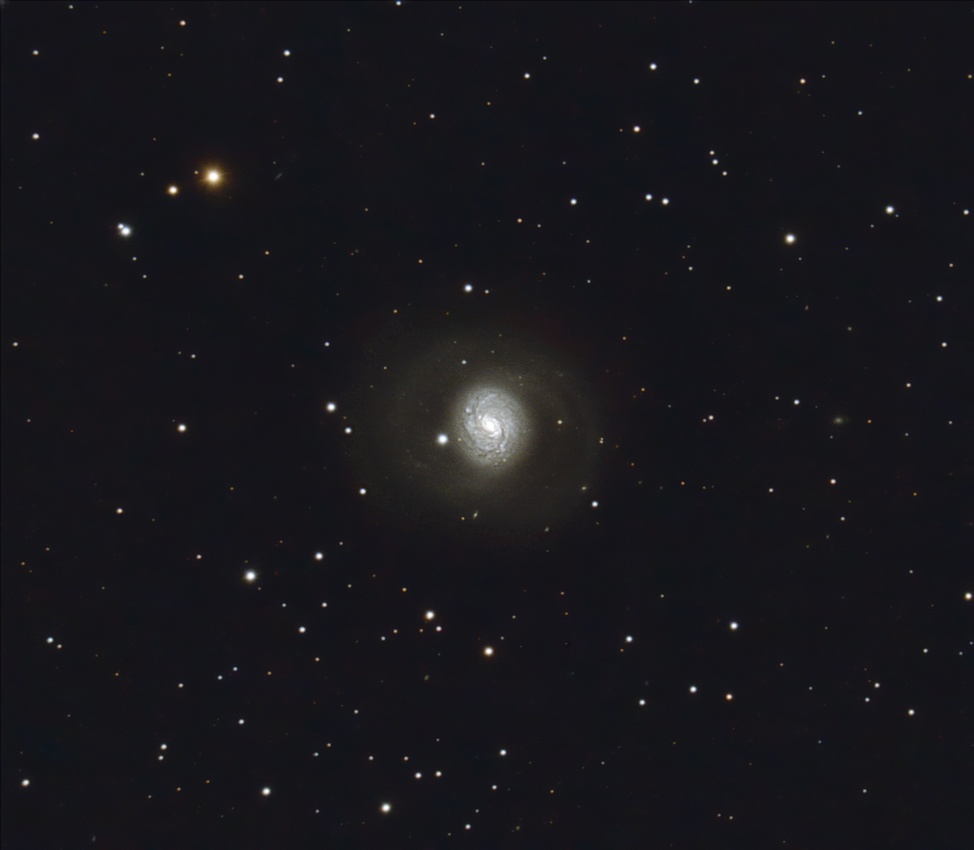
Seyfert galaxies feature an active galactic nucleus that shines with the equivalent luminosity of the entire Milky Way. Thanks to this bright core, Messier 77 is one of the easiest galaxies to pick out from washed-out skies. Start at Menkar and hop to gamma Ceti, then to delta Ceti, then drift your scope less than a degree south-east of delta Ceti:
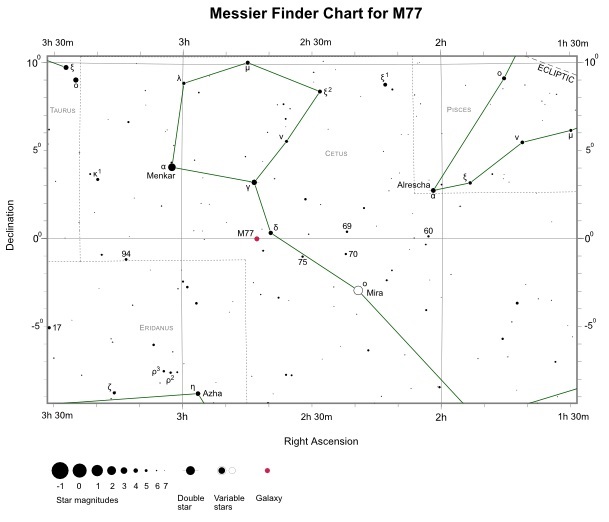
The Andromeda Galaxy and Companions (M31, M32, M110)

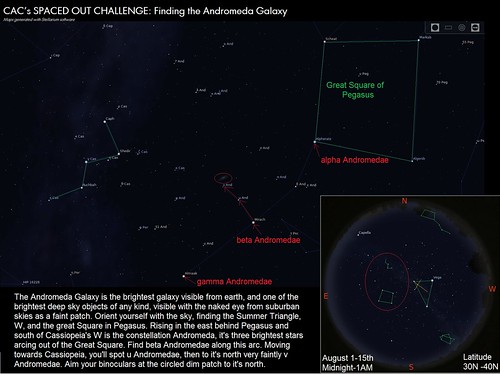
Through a modest telescope, the satellites and dust lanes come into better focus than with binoculars; with a scope of at least 4" aperture, starfield NGC 206 becomes visible. Below is a guide for the brightest features visible in most amateur scopes:
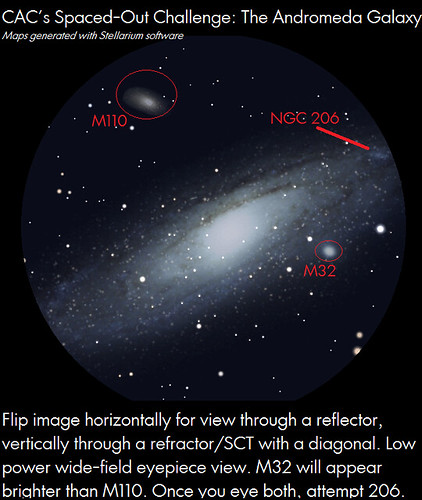
Around 9PM, the Messier objects of the winter sky have drifted west and will soon set.
Overview map: View image
The Pleaides (M45)

One of the few Messier objects that is bright enough to cut through the worst light pollution, The Pleiades, or Seven Sisters, are plainly visible as a smudge in city skies, resolving to a tight cluster in suburban skies, and are just stunning in a pair of binoculars or a small telescope. Owners of 3" refractors, rejoice: your view is more impressive than the owner of a large dobsonian.
A challenge when observing this wonder is to try to spot the faint nebulosity visible in photographs. The Merope nebula is the easiest to catch from a fairly dark location, and ads to the beauty of this open cluster.

The Crab Nebula (M1)
Aim your telescope at Zeta in Taurus (the horn star not shared with Auriga) (see pop-out map View image) with a low-power eyepiece, pop in an O-III filter behind your eyepiece, and gently roll around Zeta until it just barely pops out of view. With your eyes dark-adapted, you will notice a faint smudge of light. Crank up your power and take a peak.
The Headlights-in-Fog Nebula (M78)

When you have astrophoto eye candy like the Horsehead, and the visual blowout that is the Great Nebula, it's easy to ignore M78, a bright emission nebula that is beautiful in it's own right. Finding M78 is a bit tricky not due to a lack of brightness but it's size:much smaller than the nebula complex around Alnitak and a mere fraction of M42. I found the best way to catch this small wonder is to start at Eta Orionis, and trace a line through Alnilam onto the nebula:

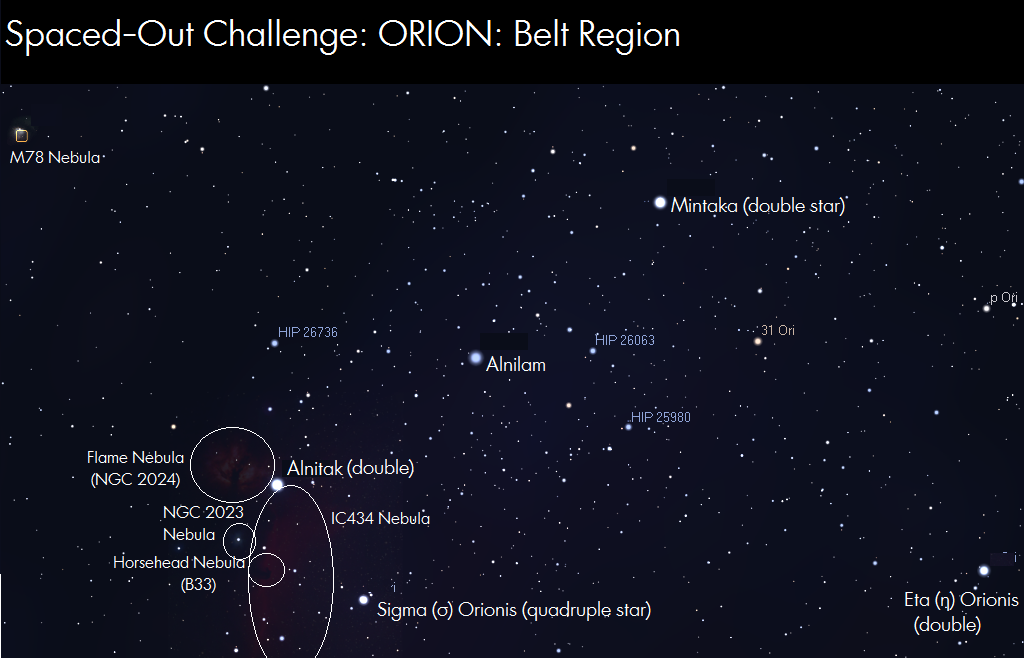
Alnilam is almost exactly halfway between M78 and Eta. For those living in more urban zones, start at the bright star Alnitak, and drift just a few degrees to the north at low power, looking for two stars with a fuzzy appearance. At higher power, the nebula resembles a pair of headlights in fog, and in larger aperture telescopes, a second reflection nebula appears nearby.
The Orion Nebula & De Marian's Nebula (M42 & M43)
DeMarian's Nebula (M43)
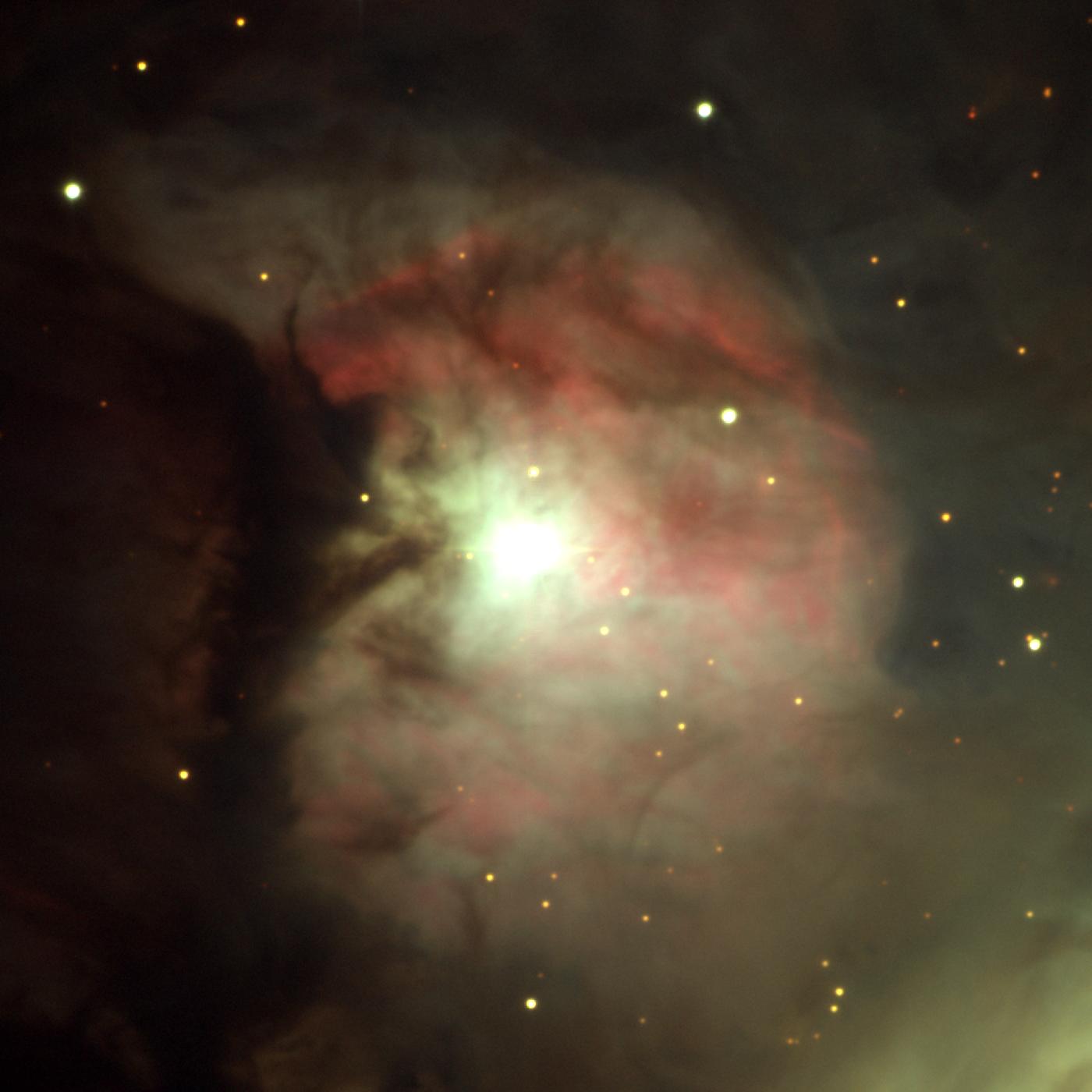
Separated from the main Great Nebula by a darkened mass of Hydrogen, DeMarian's is a region of excitement in it's own right: star formation has been observed within in as close to real time as astronomy could allow. Use an O-III or UHC filter to bring out the finer details within.
The Greatest Nebula: M42
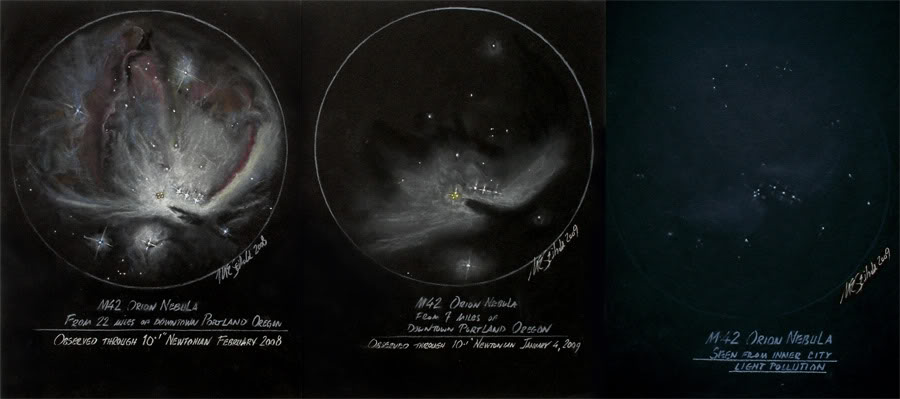
The Great Nebula in Orion has been photographed more than any other deep sky object, and it's not hard to see why: bright, expansive, and colorful, it has been observed for over four hundred years yet reveals surprises at a constant pace. The beautiful Trapezium stars, which illuminate much of the nebula, are found at it's heart. This quadruplet actually has two fainter members that can be picked out with larger telescopes, and was first documented by Galileo. At only 100,000 years old, these stars are some of the youngest objects we can spot in the sky. Theta 2 is a nearby double that also helps to illuminate the billowy cloud. The nebula is impressive from even the worst sky, and leaves you at a loss of words from a dark one. Color is absolutely visible with adapted eyes from a dark site. I've noticed traces of purple, blue and green through my 8" XT8.
The Great Dog Cluster (M41)
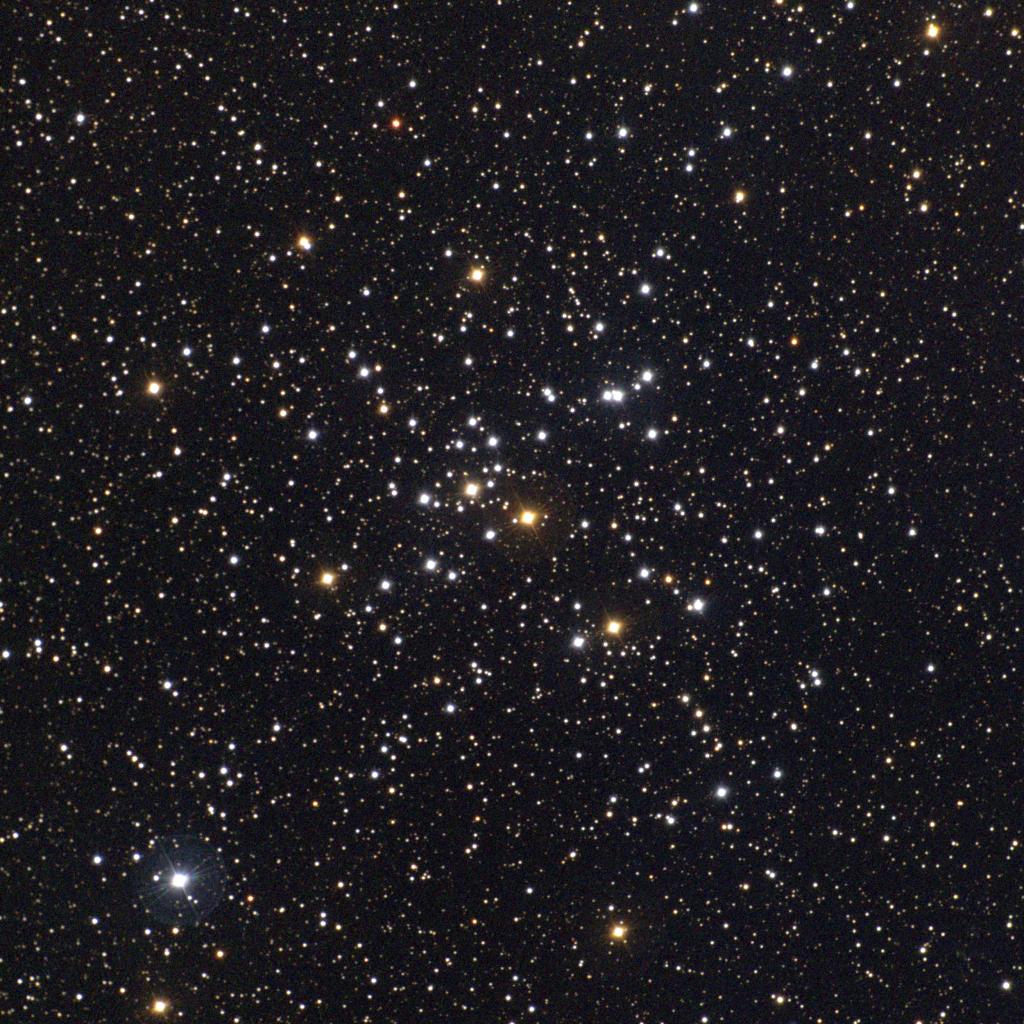
Lying about four degrees below Sirius is one of the easiest of the clusters to hunt down:

Small telescopes and large binoculars reveal the color contrasts: a few red giants are sprinkled within this 190 million-year-old hundred-member cluster. This is the easiest deep sky object to spot in the Big Dog: I've eyeballed it from my suburban observing site.
The Gemini Cluster (M35) & Companion
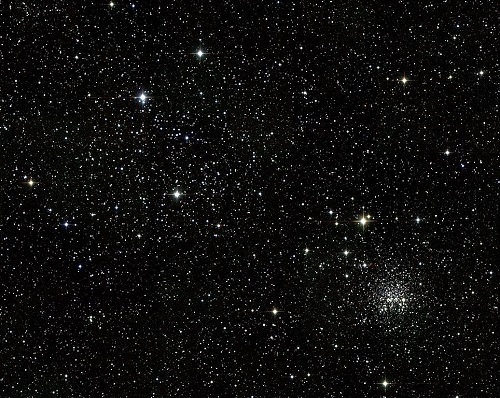
Two gorgeous open clusters with markedly contrasting shapes can be found at the feet of the Castor twin. Messier 35 is the larger, easier to resolve one, about 2800 light years from earth. M35 covers an area of sky roughly that of the full moon and has an apparent brightness of 5.3, so it easily appears in binoculars from urban skies. M35 appears at its best in binoculars or wide-field, low power eyepieces.
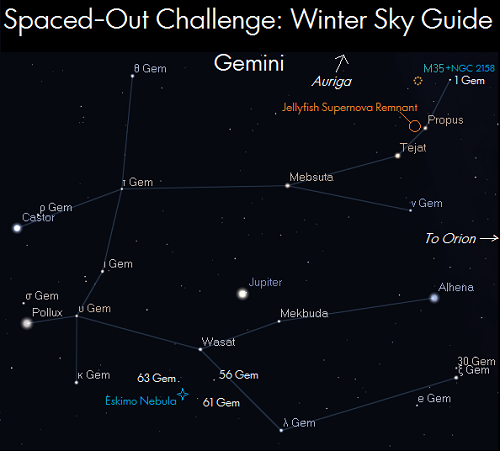
The smaller, more compacted open cluster NGC 2158 will appear as a faint fuzzball planted within a corner of your view of M35, but is in fact over 8,000 light-years more distant. Telescopes with apertures of at least 4" can readily resolve this ancient grouping.
The Beehive (M44)

From your dark sky location, the faint constellation Cancer will be visible, and you'll notice a dusty patch known since antiquity: the Beehive. One of the few Messiers that looks more impressive through binoculars than a telescope, it's a nice stunner, and the last object within our Milky Way we will target for some time.
We transition to intergalactic space for much of this batch of targets.
Late evening pop-out overview here: View image
Southern Pinwheel Galaxy (M83)

About the object:
One of the closest and brightest barred spiral galaxies to us, M83 anchors a "group" that includes Centaurus A discussed on an earlier astronomy thread, though the grouping is now in question as the proper motion of these galaxies isn't what it first seemed. It's brightness places it well within binocular range in dark sky sites. Here's how to find it.
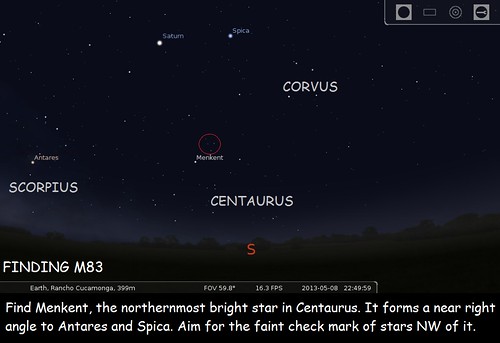
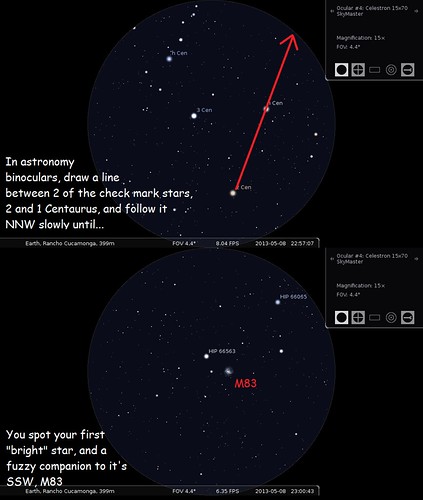
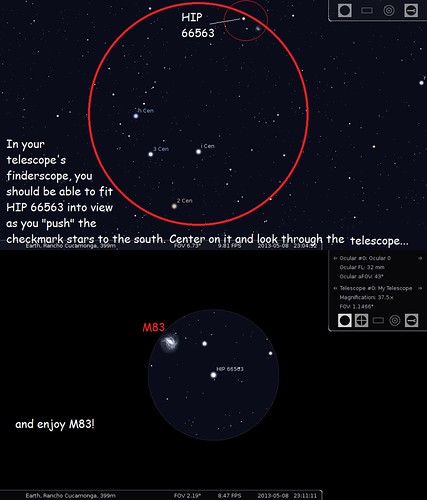
Sombrero Galaxy (M104)

The Sombrero is easily one of the most striking galaxies known, and for you older morons, it should be memorable: it's one of the interstellar objects featured in the credits of the original Outer Limits. This galaxy is easily visible with binoculars as small as 8x42s, but to save yourself the hassle I recommend a modest pair of 15x70s. As for the telescope owners, aim for this if you're armed with at least 4" of aperture, and if you hope for details, an 8" reflector or better.
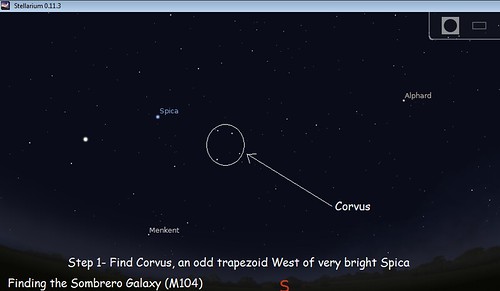
You'll use your eyes to make the first few star hops, and then use your binoculars or telescope:
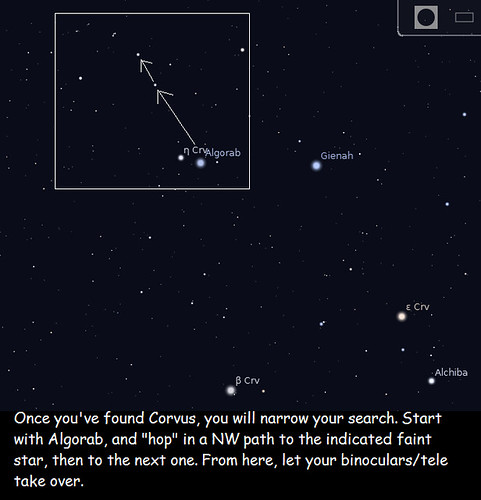
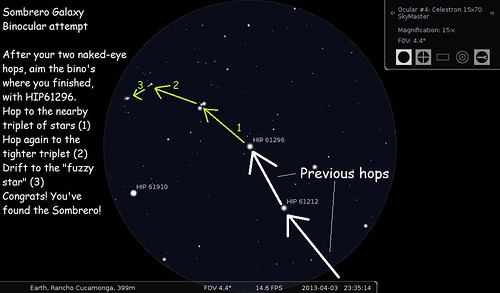
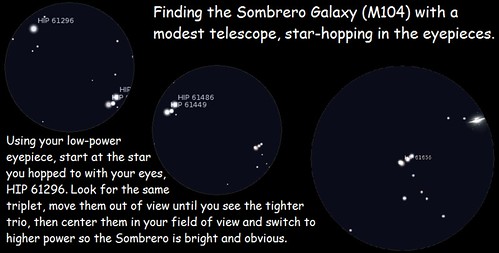
M3

M3 is a globular cluster about 33,000 light years away, and from our perspective is located near the swarm of Virgo-Coma Berenices galaxies, 2/5ths of the way along a line from Arcturus to Car Caroli (closer to Arcturus).

The Croc's Eye Galaxy (M94)
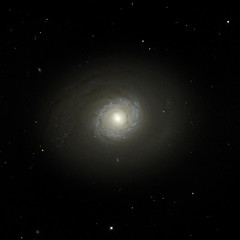
Messier 94 is a barred spiral galaxy with a unique dual-ring structure whose inner ring is an intense region of star formation. The galaxy is also unique for apparently having little dark matter, though that could just be an observational glitch.
Draw a line from Arcturus to the bottom star in the back of the dipper. The only bright "star" that will appear along it is your starting point, Car Caroli. Once you've found the target "jump off" star, just follow the hops and let your mind make the patterns:

And the final view from city skies through the binos:
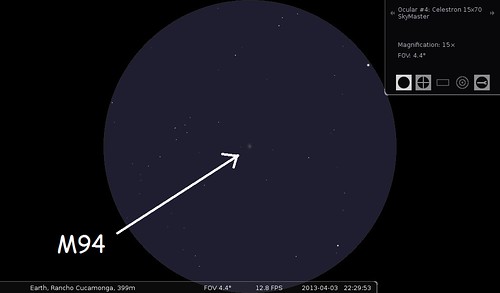
For the telescope owners, here's how to star-hop in the eyepiece to M94:

And a medium-power final result:

Leo Triplet (M65, M66, and NGC 3628)

About the object:
This small galaxy group is about 35 million light years distant and features two spiral galaxies, one face-on (M65), one more angled (M66), along with an unbarred spiral seen near-edge-on with a prominent dust lane (NGC 3628 ).


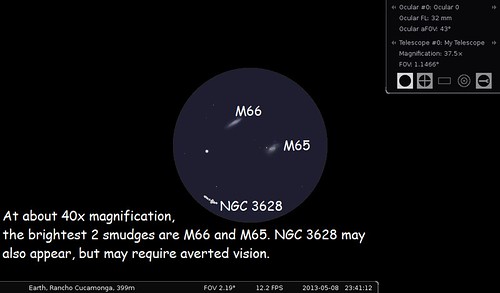
The Whirlpool Galaxy (M51)

A gorgeous galaxy right below the handle of the dipper, the Whirlpool impresses from even a suburban zone. A smaller satellite is in the early stages of being devoured and will appear in even small telescopes. The below finder chart shows both M51 and another grand spiral, M101. The Whirlpool can my found by hopping off the tip of the Big Dipper's handle to 24 CVn and then zagging towards Car Caroli by about the same distance. It will be unmistakable from a dark site:

The Piwheel Galaxy (M101)

One of the grandest galaxies, its disk pops easily in small binoculars from a dark site, but can be notoriously hard to find in a large telescope from an urban one. Moderately-sized reflectors can pull out star formation regions and star clusters, and the arms are clearly visible with steady air and dark skies. M101 forms an equilateral triangle with the two end stars of the Big Dipper's handle (see chart above from M51).
Bode's Nebula: M81 and M82 in Ursa Major
Note, this is reprinted from our supernova alert thread in January. The SN is fading, but may still be visible in amateur scopes during the March 1st full moon weekend
First, look to your north for the Big Dipper, the bright asterism within the large constellation Ursa Major:

Trace a line from the back star of the bowl, Phad, to the northernmost front star of the bowl, Dubhe, and continue in the same distance and direction:

Looking through your finderscope or eyepiece, you should then see two faint patches of light. If not, you're just a push or two away, so scan around slowly, until you notice the two patches:

More Maps and Gizmos:
For a comprehensive charting of all 110 objects, Rob Hawley has made a fanatastic star-hop guide for all of the targets here.
For better planning of targets, calculated to your specific latitude, use Larry McNash's planner here.
The full Beginner's Buyer's Guide, our Comet Guide (featuring additional grab-and-go telescopes), and any other edition you're looking for can be found in the master index of all Spaced-Out Challenge threads here, but of course you can always inquire about binoculars, telescopes, and all the rest in the comments. As always, if you have astrophotography, product recommendations, or astronomy news you'd like to see on a future Spaced-Out Challenge, email me at theoneandonlyfinn (at) gmail.com, or tweet me @conartcritic.
If you have any more questions about your new optics, feel free to ask below. Until next time, clear skies to you, and keep looking up!
Next week, we continue our Messier Marathon Guide
While nothing can beat an immaculate night sky, the experience of these flashing visitors streaking through the summer Milky Way can be enjoyed within a reasonable driving distance wherever you may be, weather permitting. Many states and towns have dedicated parks as "dark sky preserves" and are more than willing to accommodate the needs of local amateur astronomers.
Locations marked in italics are among the darkest places in the nation. A few of these have been pulled from Phil Harrington's excellent resource observingsites.com along with the Jshine map, where additional details for access are necessary I've linked to these sites directly. Caution: contact info for most sites is listed, but with ANY rural site be cautious about potentially dangerous unknowns such as blind cliffs and drops. It is strongly recommended you visit a site before sundown to familiarize yourself with your site.
Mobile: Little River State Forest 1 hr NE of Mobile
Montgomery: Grady and environs 45 minutes from Montgomery
Birmingham: Dirt parking lot/turnabout at Alabama 13 x 102 Vehicle traffic at minimum after sundown, 1 hr from Birmingham.
Coffeeville Reservoir Darkest sky in the state, 2 hr N of Mobile.
Go outside of your “town” and look up, so long as you aren't experiencing the Midnight Sun.
Recommended (actively advertising for the Perseids): Eagle River Nature Center
The Grand-Daddy of Dark Sky Destinations, the Milky Way lights up the summer sky everywhere but within the major metro areas (excluding Flagstaff- it's dark sky program means residents can walk to a nice sky).
Phoenix: (DARK sky site with amenities)- Alamo Lake State Park 2.5 hr W of Phoenix
Phoenix/SW Arizona: (DARK sky site go in groups due to desert)- The Antennae Observing Site 1.5 hr W of Phoenix
Phoenix: (closer, brighter dark sky site)- roadtrip W to Wickenburg 1 hr NW
Tucson: Kitt Peak National Observatory (Nightly Observing Program) Call ahead to enjoy a great evening, shuttle service available. Fantastic skies 90 minutes from Tucson.
North: Grand Canyon-North Rim Not only the darkest skies in the state, but some of the darkest on earth.
Northwest: Redding Recreation Area in Ozark
Little Rock: Petit Jean State Park 1 hr drive NW
Texarkana: Millwood Lake (North Side)
Southeast: Scrubgrass Campground One of the darkest in the state, if not the darkest.
Northern California, especially around Shasta, is an astronomer's paradise.
The High Sierras and the Mojave offer spectacular views to visitors and residents alike.
Northwestern: Hyampom Airport
Northeastern: Baum Lake
Bay Area North: Doran Regional Park 1.5 hr N of San Fransisco.
Sacramento: TAC-SEC's Ice House Observation Plateau Sites additional driving directions here
Bay Area South: Henry W Coe State Park 50 minutes from San Jose
Fresno: Spring Cove in Sierra National Forest 1 hr drive from Fresno
Carmel/Salinas/Monterrey: Pfeiffer Big State Beach at Big SurIncredible views of sea, sand and sky an hour south on Rte 1.
Central Coast/San Luis Obispo: Lake San Antonio <1 hr from SLB.
Bakersfield/Kern: Walker Pass Campground <1.5 hr East from Bakersfield. Very dark sky.
High Sierras/Eastern: Grandview Campground Very, very dark skies near Bishop.
Darkest sky in SoCal: Mesquite Spring Campground in Death Valley National Park most recent addition to the International Dark Sky Association's certified parks.
Vandenberg AFB/Santa Maria/Santa Barbara: VAAS' Figueroa Mt Site 1 hr drive from SB/SM/VAFB
Los Angeles/Ventura: Mount Pinos 1.5 hrs NW from downtown L.A. Haven for Angeleno amateur astronomers and astrophotographers.
Orange County/Inland Empire:
(Mountains)-Silverwood Lake Cedar Dam area.5-1hr from I.E. cities
(Desert-North) Amboy Crater Town of Amboy with iconic Roy's Gas, cold water and snacks nearby. Bathrooms and fountains. Parking area is remote, about a half mile from Route 66 which itself is rather remote. This is the darkest point in California south of Death Valley.
(Desert-South) Joshua Tree National Park Cottonwood Campground 1.5 hr E of Riverside
San Diego: Anza-Borrego Desert SP and environs 1.5 hr from downtown SD. Community within park also a great dark sky spot.
Outside of the Fort Collins-Pueblo string of cities, a five minute trip outside town gives you pristine skies.
Denver: Caribou Ranch Open Space 1.5 hr W of downtown Denver
Colorado Springs: Eleven Mile State Park 1 hr drive from Colorado Springs
Comanche National Grassland Darkest site in Colorado, one of the darkest in North America.
White Memorial Conservation Center, Litchfield, CT Darkest easy-access site in the state. Milky Way visible from here. <1 hr drive from Hartfort, Bridgeport, or New Haven.
Trap Pond State Park near Laurel Yep, even Delaware has some darkness.
W of I-75 and N of Rte 98 is almost entirely dark sky. Wilderness snaking through the lower middle around Lake Okeechobee. If your town is within these areas, huzzah.
Panhandle: Falling Waters State Park <1.5 hr from Pensacola
Tallahassee: Bald Point State Park- Sunrise Beach Access parking lot and point are unlocked after hours per park staff, park in specified area. Very dark skies less than an hour from Tallahassee.
Jacksonville: Goldhead Branch State Park 1 hr drive time, reasonably dark skies.
Gainesville/Ocela: Shired Island 2hr drive time, darkest skies in the state.
Tampa Bay: Duette Preserve Parking Area closed at sundown, lots open 24/7. 1 hr drive time from Tampa/St Petersburg.
Orlando: Lake George State Forest 1.5 hr drive time
Naples and Miami: Kirby Storter Roadside Park 1 hr W of Miami, E of Naples on the 41.
Key West: Spanish Harbor KeyThe Girl Scout Camp here is used for the Winter Star Party.
If you can afford the trip: Dry Tortugas National Park. A challenge to get into, but one of the darkest sites on earth.
Great skies in the north along the Smokies, the southern border with Florida is swampy but dark as well.
Atlanta/Macon/Augusta/Athens: Ocatee Observing Field Within 1.5 hr drive from all of these cities.
Valdosta: Stephen C Foster State Park <1.5 hr east of Valdosta, darkest in the state.
Southwest/Columbus: Providence Canyon State Park (overlooks) <1 hr from Columbus STAY IN THE PARKING/OVERLOOK AREA. CANYON DROPS SUDDENLY.
If you can't get atop Mauna Loa:
Haleakala National Park next-darkest in the state, one of the darkest in the US.
Another state with incredible skies throughout, there is a small region in it's SW corner, bordering Nevada, that is one of the darkest sites on earth:
Duck Valley Indian Reservation Mountain View Reservoir Bortle Zone 1 Sky
Chicagoland: Green River Conservation Area near Dixon <2 hrs West
Central: Jim Edgar Panther Creek State Conservation Area
Southern: Shawnee National Forest Darkest skies in the state.
North: Potawatomi Wildlife Park First Dark-Sky Preserve in Indiana <1hr from South Bend, 1 hr from Ft Wayne
Indianapolis/Central: Camp George Cullom in Frankfort <1 hr from downtown Indianapolis
South:Patoka Lake & Environs <1.5 hr from Evansville, Bloomington
Much of Iowa is blue/green zone outside of the towns and cities.
Eastern: Buzzard Ridge Wildlife Area <1.5 hr from Cedar Rapids, Iowa City, Davenport
Central/Des Moines: Springbrook State Park 1 hr from Des Moines
Western: Thul Woodland 1 hr from Souix City
Nine Eagles State Park Darkest site in Iowa
Virtually anywhere 15 minutes outside of town (western three fourths of the state)
Nearest Wichita: Cheney just 25 miles West.
Topeka/KC: Hwy 99&Cyclone Very dark sky
Plenty of rural locations, especially in the eastern third.
Eastern: End of Chimney Top Road in Daniel Boone National Forest
Western: Land Between the Lakes Recreation Area
North: Caney Creek Lake State Park
Central: Catahoula Lake in Catahoula NWR
New Orleans: Delta NWR <1.5 hr from downtown
West: Rockefeller State Wildlife Refuge and Game Preserve
Northern half of the state is near-pristine.
Acadia National Park Darkest easy-access site in the state.
Baltimore Metro: Green Ridge State Forest near Flintstone, MD Darkest sky in the state.
Southern/DC Metro: Point Lookout State Park
Eastern Shore: Tuckahoe State Park near Denton
Shady Pines Campground, near Savoy, MA Darkest sky in the state, <2hr drive time to Boston
Marconi Beach <90 mins from Boston
Detroit Metro: Lake Hudson State Recreation Area The First Dark Sky Preserve in Michigan. 90 minutes from Detroit, 1 hr from Ann Arbor
North/Central: Lumberman's Monument National Forest Svc. Campground & Park
Upper Peninsula: North Country Natl Scenic Trail- Hiawatha National Forest Darkest Site in Michigan
Another state dominated by darkness with too many sites to list.
Duluth: Savannah Portage State Park
Twin Cities: Father Hennepin State Park 1.5 hr N of Minneapolis-St Paul
NW: Old Mill State ParkVery dark, almost "disorienting".
Voyaugers National Park Redefines the definition of dark. Incredible site, darkest in the state.
Extensive forest makes for dark but obscured viewing in much of the state, but most fishing lakes and reservoirs throughout offer decent horizons and dark skies.
Biloxi: De Soto National Forest Any open lot within the park, about an hour north.
Jackson: Lake Lincoln State Park 1 hr S of Jackson
Near Kansas City: Refer to the KANSAS listing for Topeka for a close point west, within MO closest site is Bunch Hollow Conservation Area
Near St Louis Metro: Council Bluffs Recreation Area DARK site 2 hrs from STL
Near St Louis: Cuivre River State Park 1 hr from downtown
Most of Missouri in between the big cities is blessed with good skies once you get about five minutes away from bright lights. There is one place though which is pure magic.
A very specific spot in the Ozark National Scenic Riverways Darkest sky in the state, one of the darkest along the Mississippi.
Virtually anywhere
UL Bend National Wildlife Refuge Darkest sky in the state
Virtually anywhere 15 minutes outside of town (western two-thirds of the state)
Nearest Omaha: Burchard Lake Dam
Merritt Reservoir Darkest sky in the state
Austin, NV Darkest site in the state.
Las Vegas Metro: Glendale/BLM area
Most parts north of the NH/MA line are in the green.
Dixville Notch State Park Darkest site in the state
North: Jenny Jump State Forest near Hope
South: Belleplain State Forest (recreation fields) near Woodbine darkest site in the state
Much of the state is extremely dark, but here are few notable spots.
Northeast: Clayton Lake State Park Very dark sky.
Santa Fe/Las Vegas: Fort Union National Monument
Albequerque: San Lorenzo Canyon
Alamagordo/South: Three Rivers Petroglyph Rec Site
Southeast: Carlsbad Caverns Visitor Center
Gila Cliff Dwellings National Monument Among the darkest places on earth. Milky Way takes on a three dimensional appearance.
Northern New York: Adirondacks, Darkest site in New York State is arguably Raquette Lake.
Western New York: Long Point State Park near Bemus Point
Long Island: Custer Institute in Southold Milky Way is visible here, <2 hr drive from NYC
Southern New York/Closest DARK site to New York City: Pepacton Reservoir <2.5 hr drive time from downtown Manhattan
Western/Asheville: Wayah Bald Darkest point in the Smokies
Northwestern: Doughton Park
Eastern: Pettigrew State Park near Creswell Very Dark Skies
Central/Charlotte/Winston-Salem/Raleigh/Greensboro: Roy J Maness Nature Preserve Within a 1.5 hr drive from all of these cities.
Wilmington/Southern: Bladen Lakes State Forest 1 hr from Wilmington
Outer Banks: National Seashore Cape Hatteras- Ocracoke Island Campsites One of the best dark sky sites in the United States. Eastern sky is immaculate.
Virtually anywhere 10 minutes outside of town
Little Missouri National Grasslands Darkest sky in the state
NW/Toledo: Harrison Lake State Park <1 hr from Toledo
Columbus: Woodbury Wildlife Area <1.5 hr east of downtown
Cincinnati: Stonelick Lake State Park Less than 50 minutes from downtown, best site in SW Ohio.
Cleveland: Dorset Wildlife Area Parking Lot <1 hr from downtown
SE/Appalachia: Lamping Homestead Picnic Area, Wayne Natl Forest Darkest site in the state.
Virtually anywhere 10 minutes outside of town west of Oklahoma City-Tulsa
Nearest Oklahoma City/Tulsa: Robbers Cave State Park Closer spots lie between Holdenville and McAlister, but this is the closest dark campground area.
Black Mesa State Park One of the darkest skies on earth. Words fail.
Eastern Oregon, from Bend on, is some of the darkest sky on earth.
Near Portland: L.L. Stub Stewart State Park <40 minutes from downtown.
Southern/Central: Crater Lake National Park Incredible skies, to it's south east some of the darkest on earth.
Cherry Springs State Park The darkest site in Pennsylvania, and one of the darkest in the Eastern United States. Second International Dark Sky Park named.
Scranton: High Knob Overlook
Pittsburgh Area: Ryerson Station State Park <1.5 hrs from downtown
Philadelphia Area: Hawk Mountain Road, State Game Lands Area #106 <1.5 hr from downtown Philly
Harrisburg/Gettysburg: Pine Grove Furnace State Park
York/Lancaster/AmishMafiaVille: Susquehannock State Park
Frosty Drew Obeservatory, Charlestown, RI Darkest site in Rhode Island, Milky Way is visible from here. <1 hr from Providence.
Western: Bad Creek DamVery dark sky, access road provided by Duke Energy, <2 hr from Spartanburg
Columbia and Charleston: Lone Star Ghost Town Not quite dead yet, but plenty of open spots for parking and observing. 1 hr from Columbia, 70 minutes from Charleston.
Virtually anywhere 10 minutes outside of town
Rabbit Creek Reservoir Darkest sky in the state
Western/Memphis: Chickasaw State Park (around Lake Placid) 1.5 hr east of Memphis
Nashville/Central: Water Valley Overlook on Natchez Trace Pkwy milepost 411.8, 1 hour from Nashville.
Eastern/Chattanooga/Knoxville: Cherohala Skyway Turnoffs Darkest location in the state.
West Texas has incredible sky, just ask any Texan. Even in the more "congested" parts of the state there are some great sites within a short drive.
Big Bend National Park- Persimmon Gap Picnic Area Mind-blowingly dark.
Amarillo: Rita Blanca National Grassland Very, very dark sky. 2 hr drive N to near OK border.
Dallas/FtWorth/Austin: Hubbard City Lakes
Houston: Lake Livingston (North End)
San Antonio/Laredo/Corpus Christi: Big Alamo Tank
Dark skies abound out here, but if you live in Provo/SLC you'll need more of a drive (about an hour) to get away from the lights. One immaculate site near the metro area can be found here. One of the darkest skies on earth can be found towards its southern border.
National Bridges National Monument The first International Dark Sky Park, and for damn good reason. Incredible scenery topped only with near-perfect skies.
Bryce Canyon National Park Darkest spot in Utah, one of the darkest on the continent.
The middle of the state is best, as light pollution from Montreal begins to brighten the northern third.
Branbury State Park Darkest in the state.
Western: Whitetop Mountain Arguably the darkest site in Virginia. Spectacular views.
Northern: Shenandoah National Park-Matthews Arm Campground drivetime 2hrs from downtown D.C.
Metro Northern VA: Sky Meadows State Park <1 hr from Arlington.
Central: Bear Creek Lake State Park
Eastern/Delmarva: Savage Neck Dunes parking lot Very dark considering it is less than an hour from Norfolk.
From Mt St Helens to the NE third, much of the state is an astronomer's paradise.
Tacoma/Seattle: Lake Easton State Park 1 hr from Seattle, 1.5 Tacoma
Spokane: Fishtrap Lake Parking Lot <30 minutes from downtown Spokane
Palouse Falls Darkest site in the state.
Charleston/West: Calhoun County Park Sky can rival Spruce Knob depending on weather.
Spruce Knob and environs The darkest site east of the Mississippi River.
Nearly all of SW and NW (particularly near Kickapoo) has excellent dark skies, the same for the regions bordering Michigan and the Iron Range.
NE Wisconsin: Newport State Park (call ahead)
Green Bay: Kroenke Lake SNA 1 hr from Green Bay
Milwaukee Metro: Kettle Moraine State Forest (North) 45 mins from Milwaukee, Fon du Lac, Sheboygan
Madison/Janesville: Magnolia Bluff Park
The Darkest Site in Wisconsin, Chequamegon National Forest
One of the few states where I can't really point out the "darkest" sky.
Hwy 131 leaving Lander south is one of the darkest of the dark.
toby928(c): "[i]I just filmed a YouTube video detailing why I l ..."
bonhomme[/i][/i][/i][/b][/b][/b][/s][/s][/s][/u][/u][/u]: "> Having been a Traffic Crash Reconstructionist in ..."
Marcus T: "It’s always fun to have those still here say ..."
Goatweed : "ICE needs upgrade their vehicles. Bulldozers an ..."
Acck, ack, ack-ack-ack, aaaaacck!: "I wonder, too... Was he placed in front of the ca ..."
vmom deport deport deport: "The gay men,however, I have seen some who are hand ..."
the dandy: ">> 382 Not a Subaru Forester? Shocking. Not even o ..."
TheJamesMadison, barreling through the action thrills with Wolfgang Petersen: "444 One of the craziest things over the last yea ..."
Obvs.: " >>> I'm pretty certain you're trying to persuade ..."
man: "That's how it starts. Then a baker's dozen. Then a ..."
Unknown Drip Under Pressure: "[i]Best Sec of State since forever. Posted by: wh ..."
Even CNN Admits That the Lunatic Lesbian Leftist Tried to Run Down the ICE Agent
Iran's Supreme Ayatollah: Protesters Are Just Working On Behalf of Donald Trump
US Marines Seize Another False-Flag Ship of the "Dark Fleet"
Helen Andrews: Somalis Have Been Scamming the Government Since They Got Here
Thanks to MAHA, Several States Just Implemented Bans on Using SNAP Benefits for Junk Food; also, A Friend of the Blog Is Running for Statewide Office in Nevada
Mid-Morning Art Thread
The Morning Report — 1/9/26
Daily Tech News 9 January 2026
Thursday Overnight Open Thread - January 8, 2026 [Doof]
Paul Anka Haiku Contest Announcement
Integrity SAT's: Entrance Exam for Paul Anka's Band
AllahPundit's Paul Anka 45's Collection
AnkaPundit: Paul Anka Takes Over the Site for a Weekend (Continues through to Monday's postings)
George Bush Slices Don Rumsfeld Like an F*ckin' Hammer
Democratic Forays into Erotica
New Shows On Gore's DNC/MTV Network
Nicknames for Potatoes, By People Who Really Hate Potatoes
Star Wars Euphemisms for Self-Abuse
Signs You're at an Iraqi "Wedding Party"
Signs Your Clown Has Gone Bad
Signs That You, Geroge Michael, Should Probably Just Give It Up
Signs of Hip-Hop Influence on John Kerry
NYT Headlines Spinning Bush's Jobs Boom
Things People Are More Likely to Say Than "Did You Hear What Al Franken Said Yesterday?"
Signs that Paul Krugman Has Lost His Frickin' Mind
All-Time Best NBA Players, According to Senator Robert Byrd
Other Bad Things About the Jews, According to the Koran
Signs That David Letterman Just Doesn't Care Anymore
Examples of Bob Kerrey's Insufferable Racial Jackassery
Signs Andy Rooney Is Going Senile
Other Judgments Dick Clarke Made About Condi Rice Based on Her Appearance
Collective Names for Groups of People
John Kerry's Other Vietnam Super-Pets
Cool Things About the XM8 Assault Rifle
Media-Approved Facts About the Democrat Spy
Changes to Make Christianity More "Inclusive"
Secret John Kerry Senatorial Accomplishments
John Edwards Campaign Excuses
John Kerry Pick-Up Lines
Changes Liberal Senator George Michell Will Make at Disney
Torments in Dog-Hell
The Ace of Spades HQ Sex-for-Money Skankathon
A D&D Guide to the Democratic Candidates
Margaret Cho: Just Not Funny
More Margaret Cho Abuse
Margaret Cho: Still Not Funny
Iraqi Prisoner Claims He Was Raped... By Woman
Wonkette Announces "Morning Zoo" Format
John Kerry's "Plan" Causes Surrender of Moqtada al-Sadr's Militia
World Muslim Leaders Apologize for Nick Berg's Beheading
Michael Moore Goes on Lunchtime Manhattan Death-Spree
Milestone: Oliver Willis Posts 400th "Fake News Article" Referencing Britney Spears
Liberal Economists Rue a "New Decade of Greed"
Artificial Insouciance: Maureen Dowd's Word Processor Revolts Against Her Numbing Imbecility
Intelligence Officials Eye Blogs for Tips
They Done Found Us Out, Cletus: Intrepid Internet Detective Figures Out Our Master Plan
Shock: Josh Marshall Almost Mentions Sarin Discovery in Iraq
Leather-Clad Biker Freaks Terrorize Australian Town
When Clinton Was President, Torture Was Cool
What Wonkette Means When She Explains What Tina Brown Means
Wonkette's Stand-Up Act
Wankette HQ Gay-Rumors Du Jour
Here's What's Bugging Me: Goose and Slider
My Own Micah Wright Style Confession of Dishonesty
Outraged "Conservatives" React to the FMA
An On-Line Impression of Dennis Miller Having Sex with a Kodiak Bear
The Story the Rightwing Media Refuses to Report!
Our Lunch with David "Glengarry Glen Ross" Mamet
The House of Love: Paul Krugman
A Michael Moore Mystery (TM)
The Dowd-O-Matic!
Liberal Consistency and Other Myths
Kepler's Laws of Liberal Media Bias
John Kerry-- The Splunge! Candidate
"Divisive" Politics & "Attacks on Patriotism" (very long)
The Donkey ("The Raven" parody)

